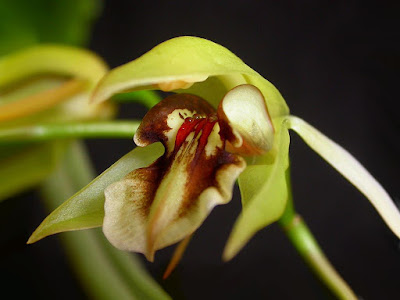Coelogyne fuscescens is native to Nepal, north-east India and Myanmar. Their natural habitat extends east from Nepal through Sikkim, Bhutan and the Khasi Hill to Burma. They grow as epiphytes in mixed forests at heights of 1000-1600 m...
Coelogyne fuscescens also called as The Ocher Yellow Coelogyne, Coelogyne fuscescens var. integrilabia, Coelogyne fuscescens var. viridiflorum, Coelogyne integrilabia, Pleione fuscescens, is a species of the genus Coelogyne. This species was described by John Lindley in 1828.
IDENTIFY COELOGYNE FUSCESCENS
Coelogyne fuscescens is native to Nepal, north-east India and Myanmar. Their natural habitat extends east from Nepal through Sikkim, Bhutan and the Khasi Hill to Burma. They grow as epiphytes in mixed forests at heights of 1000-1600 m.
It is a medium to large sized, warm to cold growing, creeping epiphyte, which reaching 23-33 cm in height, with erect, clustered, cylindric-fusiform, deeply grooved with age, 8-10 cm long pseudobulbs carrying 2 apical, oblanceolate to oblong-elliptic, acute, plicate, 6 nerved, gradually narrowing below in to the short petiolate base, 15-22 cm long, 5-10 cm wide leaves.
The Ocher Yellow Coelogyne blooms in the fall and winter on an erect to suberect, 16 cm long, slightly fractiflex rachis, 2 to 10 flowered inflorescence arising with a newly emerging pseudobulb growth that is subtended by 4 to 5 short, imbricating sheaths and has deciduous floral bracts and simultaneously opening flowers. The flowers are about 6 cm in diameter, and the petals of both whorls are from pale yellowish-brown to dull brown-brown. The dorsal petal forms a deep hood above the backbone. The 3-segment lip is white with dark brown spots. Its central plot has a broadly ovoid shape with wavy edges, and the side plots are short, rounded and curved. At the base of the lip there are 3 elongated bulges.
COELOGYNE FUSCESCENS CARE AND CULTURE
Cultural information should only be used as a guide, and should be to be adapted to suit you. Your physical location; where you grow your plants, how much time you have to devote to their care, and many other factors, will need to be taken into account. Only then can you decide on the cultural methods that best suit you and your plants.
Light:
Coelogyne fuscescens needs a light level of 15000-25000 lux. The light should be filtered or scattered, and the plants never exposed to direct sunlight. Strong air movement should be ensured all the time. These plants will grow well placed near the cold air outlet of the humidifier.
Temperature:
The average temperature of the summer day is 24 ° C, the night 17-18 ° C, giving a daily difference of 6-7 ° C. The average temperature of the winter day is 16-17 ° C, the night 4-7 ° C, and the daily difference 11-12 ° C.
Humidity:
From summer to early autumn, The Ocher Yellow Coelogyne needs the humidity of 80-85%. At the end of autumn and at the beginning of winter it drops to 70-75%, followed by a further drop to 50-55% at the end of the dry season, which falls at the end of winter and early spring.
Substrate, growing media:
Coelogyne fuscescens grow well attached to pieces of tree fern or cork, but during the hot and clear summer days it requires high humidity and several waterings during the day. These plants are also planted into flat containers or baskets, using a loose, fast-drying substrate. Small or medium bark, tree fern fibers or mixtures with various additives such as charcoal, perlite, or cut sphagnum moss are often used as substrates.
You can grown in mesh baskets with 6 mm mesh, lined with coconut fiber or sphagnum moss. The substrate contains, in equal parts, fine and medium-sized tree fern fiber with the addition of 10% fine charcoal, 10% perlite or pumice, and 10% chopped sphagnum or moss. With a strong air movement, this mixture allows even shedding, because the substrate does not soak or dry completely between watering. Ferns of tree fern do not undergo too rapid decomposition, which means that it is not necessary to over-fertilize too often.
Repotting:
When the plant grows out of the basket, it can be completely repotted to a larger one without disturbing the roots. This is important because Coelogyne fuscescens do not like repotting and after repotting or dividing can recover for 2-3 years.
It is recommended cutting old pseudobulbs instead of repotting, if the substrate is not very spread. If repotting is necessary, make sure that new roots are already beginning to grow. This allows the plant to rooting as quickly as possible.
Watering:
The Coelogyne fuscescens should be kept evenly moist during the period of active growth from mid-spring to early autumn with little drying between waterings. When new growths reach maturity in autumn, the amount of water should be gradually reduced.
Fertilizer:
It is recommended to apply a 1/4-1/2 dose of orchid fertilizer weekly. From spring to mid-summer, high-nitrogen fertilizer is recommended, and then until the end of autumn high-phosphoric fertilizer.
Rest period:
During 3-4 winter months, Coelogyne fuscescens should be reduced the amount of water and allowed to dry between waterings, but they can not remain completely dry for too long. Light fogging on sunny mornings with watering every 3-4 weeks should provide enough moisture. If the pseudobulbs begin to wrinkle, the amount of water should be increased. Fertilization should be reduced or eliminated until spring,















COMMENTS